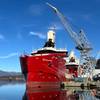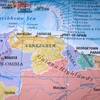Sea Ice Plays Pivotal Role in Arctic Methane Cycle
The ice-covered Arctic Ocean is a more important factor concerning the concentration of the greenhouse gas methane in the atmosphere than previously assumed. Experts from the Alfred Wegener Institute, Helmholtz Centre for Polar and Marine Research (AWI) report on the newly discovered interactions between the atmosphere, sea ice and the ocean in a recent online study in the journal Nature’s Scientific Reports.
Sea ice forms a natural barrier on the Central Arctic Ocean, limiting gas exchange between water and atmosphere. Over the past several years, the summer sea ice cover in the Arctic has rapidly decreased. “We’re investigating how the changed conditions are affecting the geochemical interaction between the ocean, ice and atmosphere,” explains Dr Ellen Damm, the first author of the study and a biogeochemist at the Alfred Wegener Institute. “We were able to confirm that the surface water in the central Arctic contains higher methane concentrations than the atmosphere, which means the Arctic Ocean is a potential source of atmospheric methane. That makes it fundamentally different from oceans in lower latitudes, which – except for a few sporadic sources – are considered methane sinks.”
For the study, Damm and her colleagues from the AWI, the Finnish Meteorological Institute and the University of Bremen analysed geochemical and oceanographic data gathered during a 2011 expedition to the Arctic with the research icebreaker Polarstern. They measured methane levels in both the sea ice and in the water directly below it, and in deeper seawater entirely unaffected by the ice. “Our study shows that there are previously overlooked feedbacks between ice melting and formation, the atmosphere, and the seawater influenced by ice,” says Damm. Among other factors, they analysed the salt solution, i.e. the brine, which is constitutes concentrated seawater resulting during the formation of sea ice. They found that the brine had a thousand times higher concentration of methane than the atmosphere – proof that sea ice can be a source of methane.
As a result of the melting and freezing processes, methane in the brine channels can be released into the seawater. Further, the water remains in stable layers, due to the different densities of freshwater and saltwater. As such, the methane from the brine channels remains in the uppermost water layer throughout the summer. When autumn storms set in and it gets colder, different water layers become mixed (convection), which can release the greenhouse gas into the atmosphere. At that time of year the sea ice cover is fragmented and the “lid” on the ocean has almost disappeared, conditions that are conducive to the release of methane into the atmosphere. The convection-based mixing continues in the winter, and methane continues to escape through the leads between ice floes.
The stable water layers prevent the methane from mixing to greater depths of the Arctic Ocean; the significantly lower methane concentrations (compared to the atmosphere) in the lower layer unaffected by the ice, verify this process. This has two effects: firstly, the newly discovered and as such not previously accounted for near-surface feedback mechanism can lead to the direct release of methane from the sea ice and ocean into the atmosphere. Secondly, the exchange between atmosphere and the deeper Arctic Ocean is reduced, which also limits the Arctic Ocean’s capacity to act as a methane sink. Co-author and AWI oceanographer Prof Ursula Schauer summarises the study’s importance as follows: “The role of sea ice in gas exchange and gas flux is much more complex than previously assumed, and the processes at work in the Northern Ocean differ greatly from those in lower latitudes. These aspects have to be kept in mind in future climate models.” Further, she points out, the study raises the question on where the methane originates. Conceivably, methane could be produced in sea ice as it drifts through the Arctic, or methane trapped in sea ice could be transported from other regions.















